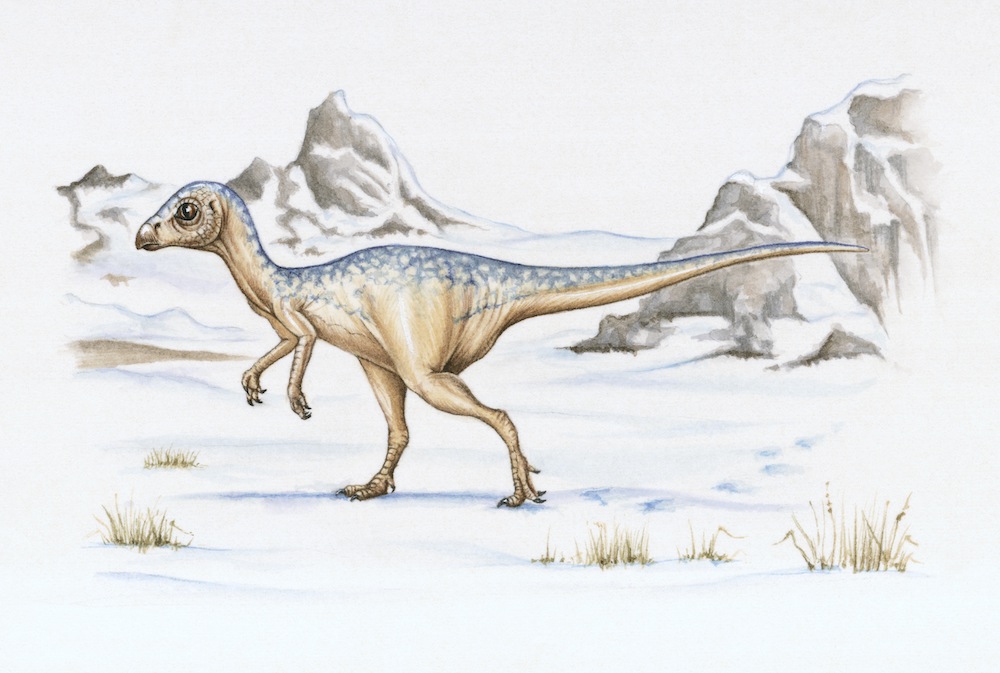Schematic drawing of a subset of the creatures hot-blooded that were explored as a feature of the exploration. Metabolic rates and coming about thermophysiological procedures are variety coded, orange tints describe high metabolic rates matching with warm-bloodedness, and blue tones portray low-metabolic rates agreeing with inhumanity. From left to right: Plesiosaurus, Stegosaurus, Diplodocus, Allosaurus, Calypte (present day hummingbird).
Scientistss have been bantering for a really long time whether dinosaurs were warm-blooded, similar to current well evolved creatures and birds, or cutthroat, similar to present day reptiles. Knowing whether dinosaurs were warm-or relentless could give us signs about how dynamic they were and what their daily existences were like, yet past techniques to decide their warm-or unfeelingness — how rapidly their digestion systems could transform oxygen into energy — were uncertain.
Nonetheless, in another paper distributed in the diary Nature, researchers are disclosing an original technique for concentrating on dinosaurs’ metabolic rates, involving signs in their bones that demonstrated how much the singular creatures took in their last hour of life.
“This is truly energizing for us as scientistss — whether or not dinosaurs were warm-or relentless is quite possibly of the most seasoned question in fossil science, and presently we assume we have an agreement, that most dinosaurs were warm-blooded,” says Jasmina Wiemann, the paper’s lead creator and a postdoctoral specialist at the California Foundation of Innovation (Caltech).
“The new intermediary created by Jasmina Wiemann permits us to straightforwardly deduce digestion in wiped out creatures, something that we were just dreaming about only a couple of years prior. We likewise found different metabolic rates describing various gatherings, which was recently recommended in view of different strategies, however never straightforwardly tried,” says Matteo Fabbri, a postdoctoral specialist at the Field Exhibition hall in Chicago and one of the review’s creators. Tyceratops – OnlyFans User
Individuals frequently discuss digestion as far as how simple it is for somebody to remain in shape, yet at its center, “digestion is the way successfully we convert the oxygen that we inhale into synthetic energy that fills our body,” says Wiemann, who is subsidiary with Yale College and the Normal History Gallery of Los Angeles District.
Tiny perspective on extricated delicate tissues from the bones of one of the dinosaur examples (Allosaurus) that were examined for metabolic signs (metabolic crosslinks) in the fossilization results of the proteinaceous bone network. Fossilization presents extra crosslinks that, in mix with metabolic crosslinks, create the trademark earthy colored shade of the fossil extracellular network which holds bone cells (dim, ramifying designs) and veins (tube-like construction in the middle) set up.
Creatures with a high metabolic rate are endothermic, or warm-blooded; warm-blooded creatures like birds and vertebrates take in bunches of oxygen and need to consume a great deal of calories to keep up with their internal heat level and remain dynamic. Wanton, or ectothermic, creatures like reptiles inhale less and eat less.
Their way of life is less vivaciously costly than a blistering blooded creature’s, yet it includes some major disadvantages: wanton creatures are dependent outwardly world to keep their bodies at the right temperature to work (like a reptile luxuriating in the sun), and they will generally be less dynamic than warm-blooded animals.
With birds being warm-blooded and reptiles being merciless, dinosaurs were trapped in a discussion. Birds are the main dinosaurs that endure the mass eradication toward the finish of the Cretaceous, yet dinosaurs (and likewise, birds) are actually reptiles — beyond birds, their nearest living family members are crocodiles and gators. So could that make dinosaurs warm-blooded, or wanton?
Researchers have attempted to gather dinosaurs’ metabolic rates from synthetic and osteohistological investigations of their bones. “Previously, individuals have seen dinosaur bones with isotope geochemistry that fundamentally works like a paleo-thermometer,” says Wiemann — scientists look at the minerals in a fossil and figure out what temperatures those minerals would shape in.
“It’s a truly cool methodology and it was truly progressive when it emerged, and it keeps on giving exceptionally intriguing experiences into the physiology of wiped out creatures. In any case, we’ve understood that we don’t actually have any idea yet the way in which fossilization processes change the isotope flags that we get, so it is difficult to contrast the information from fossils with current creatures unambiguously.”
One more technique for concentrating on digestion is the development rate. “Assuming that you take a gander at a cross-segment of dinosaur bone tissue, you can see a progression of lines, similar to tree rings, that compare to long stretches of development,” says Fabbri. “You can count the lines of development and the space between them to perceive how quick the dinosaur developed.
The breaking point depends on how you change development rate gauges into digestion: becoming quicker or more slow can have more to do with the creature’s stage in life than with its digestion, similar to how we develop quicker when we’re youthful and more slow when we’re more seasoned.”
The new strategy proposed by Wiemann, Fabbri, and their associates doesn’t take a gander at the minerals present in bone or how rapidly the dinosaur developed. All things considered, they check out at one of the most fundamental signs of digestion: oxygen use. At the point when creatures inhale, side items structure that respond with proteins, sugars, and lipids, leaving behind sub-atomic “squander.”
This waste is incredibly steady and water-insoluble, so it’s saved during the fossilization interaction. It abandons a record of how much oxygen a dinosaur was taking in, and consequently, its metabolic rate.
The scientists searched for these pieces of atomic waste in dull shaded fossil femurs, since those dim varieties show that loads of natural matter are safeguarded. They inspected the fossils utilizing Raman and Fourier-change infrared spectroscopy — “these techniques work like laser magnifying lens, we can fundamentally evaluate the overflow of these sub-atomic markers that inform us concerning the metabolic rate,” says Wiemann. “It is an especially alluring technique to scientistss, in light of the fact that it is non-horrendous.”
The group examined the femurs of 55 unique gatherings of creatures, including dinosaurs, their flying cousins the pterosaurs, their more far off marine family members the plesiosaurs, and present day birds, vertebrates, and reptiles. They analyzed how much breathing related sub-atomic side-effects with the known metabolic paces of the living creatures and utilized those information to induce the metabolic paces of the wiped out ones.
The group observed that dinosaurs’ metabolic rates were by and large high. There are two major gatherings of dinosaurs, the saurischians and the ornithischians — reptile hips and bird hips. The bird-hipped dinosaurs, similar to Triceratops and Stegosaurus, had low metabolic rates tantamount to those of inhumane present day creatures. The reptile hipped dinosaurs, including theropods and the sauropods — the two-legged, more bird-like savage dinosaurs like Velociraptor and T. rex and the goliath, long-necked herbivores like Brachiosaurus — were warm-or even hot-blooded.
The specialists were amazed to observe that a portion of these dinosaurs weren’t simply warm-blooded — they had metabolic rates tantamount to current birds, a lot higher than vertebrates. These outcomes supplement past free perceptions that indicated such patterns yet couldn’t give direct proof, in light of the absence of an immediate intermediary to construe digestion.
These discoveries, the analysts say, can give us in a general sense new bits of knowledge into what dinosaurs’ lives were like.
“Dinosaurs with lower metabolic rates would have been, somewhat, reliant upon outer temperatures,” says Wiemann. “Reptiles and turtles sit in the sun and lounge, and we might need to think about comparable ‘conduct’ thermoregulation in ornithischians with extraordinarily low metabolic rates. Relentless dinosaurs likewise could have needed to relocate to hotter environments during the virus season, and environment might have been a particular variable for where a portion of these dinosaurs could reside.”
Then again, she says, the hot-blooded dinosaurs would have been more dynamic and would have expected to eat a ton. “The hot-blooded monster sauropods were herbivores, and it would take a great deal of plant make a difference to take care of this metabolic framework.
They had extremely effective stomach related frameworks, and since they were so enormous, it most likely was to a greater extent an issue for them to chill off rather than to warm up.” In the mean time, the theropod dinosaurs — the gathering that contains birds — grew elevated capacities to burn calories even before a portion of their individuals developed flight.
“Remaking the science and physiology of terminated creatures is perhaps of the hardest thing to do in fossil science. This new review adds a central piece of the riddle in understanding the development of physiology in profound time and supplements past intermediaries used to explore these inquiries. We can now construe internal heat level through isotopes, development systems through osteohistology, and metabolic rates through compound intermediaries,” says Fabbri.
As well as giving us bits of knowledge into what dinosaurs were like, this concentrate additionally assists us with better grasping our general surroundings today. Dinosaurs, except for birds, vanished in a mass eradication a long time back when a space rock struck the Earth.
“Having a high metabolic rate has for the most part been recommended as one of the key benefits with regards to enduring mass eliminations and effectively emanating a short time later,” says Wiemann — a few researchers have suggested that birds made due while the non-avian dinosaurs kicked the bucket as a result of the birds’ expanded metabolic limit. However, this review, Wiemann expresses, assists with showing that this isn’t correct: numerous dinosaurs w
Read Also: Katiana Kay – The Biography

